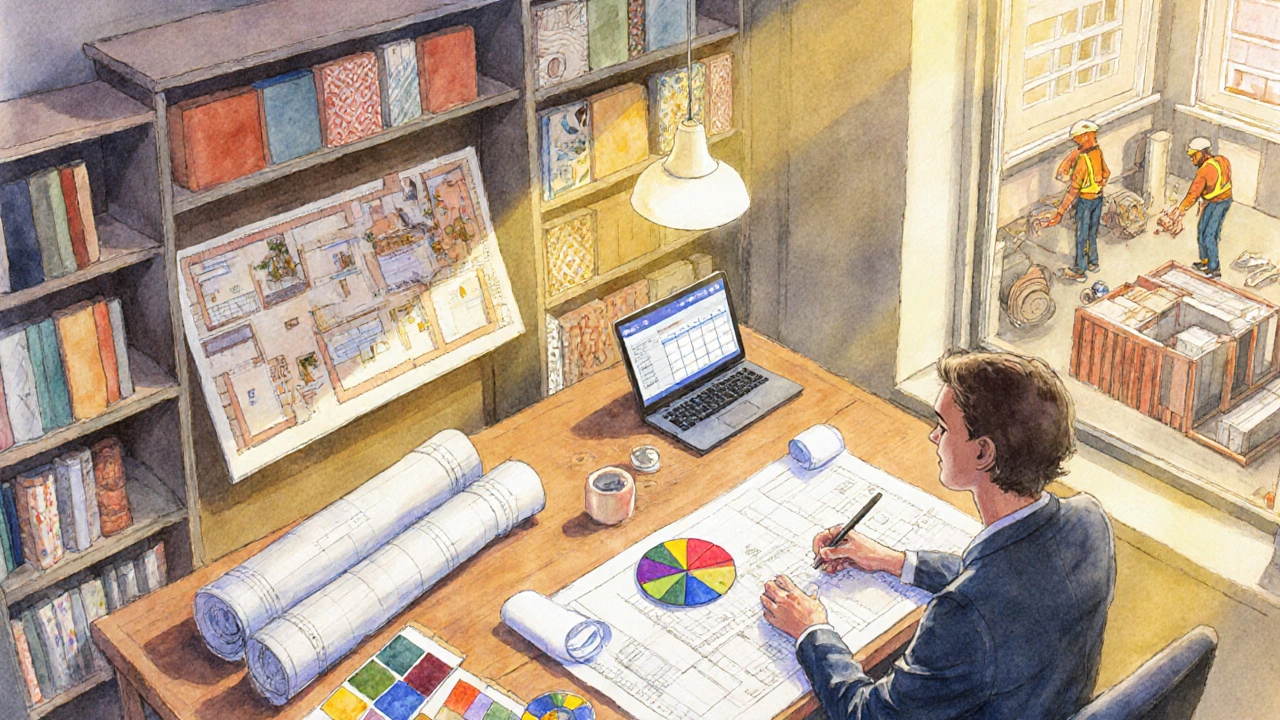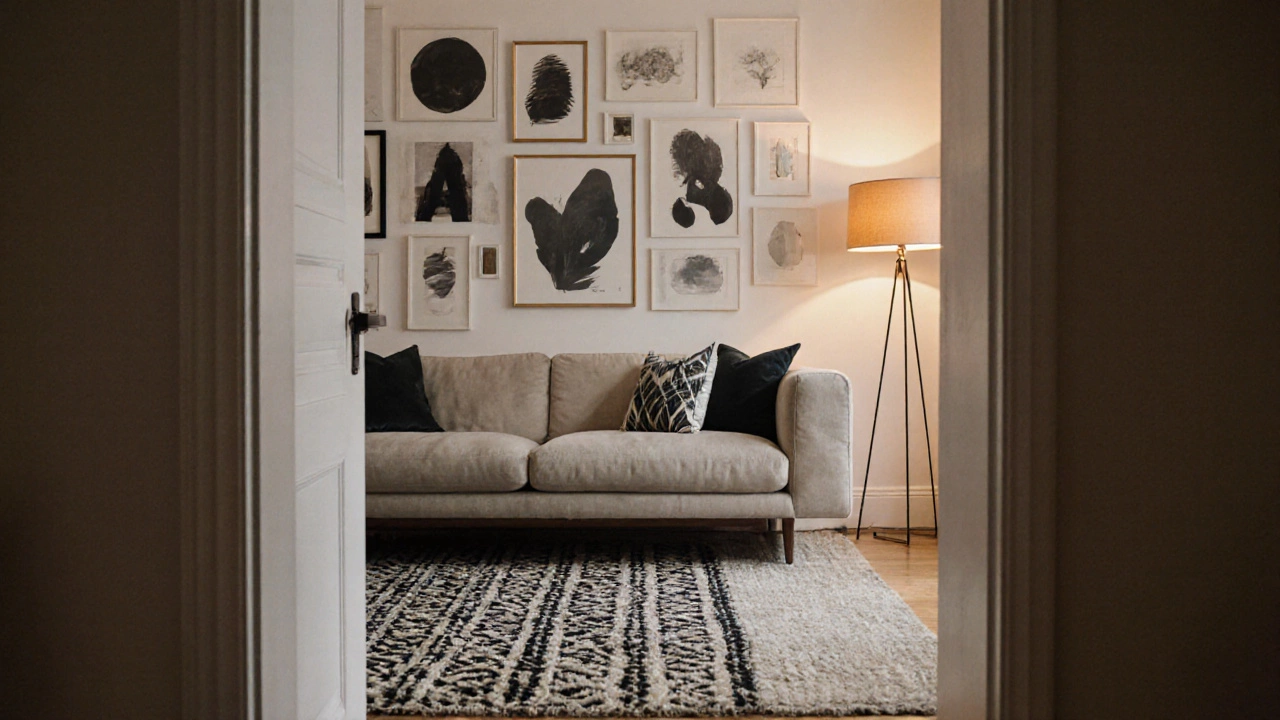Interior Design Cost Calculator
Estimate Your Renovation Costs
Get a comparison of professional design versus DIY costs based on your project details
Professional Design
Estimated cost:
Time estimate:
DIY Option
Estimated cost:
Time estimate:
Breakdown
Design Fee
Materials & Furniture
Recommended approach:
Based on your budget, time availability, and project scope. A professional designer can save you time and avoid costly mistakes, while DIY offers more creative control but requires significant effort.
When you stand in an empty room wondering how to turn it into a cozy living space, the first question that pops up is: hire an interior designer or roll up your sleeves and do it yourself? Both routes promise a fresh look, but the journey, costs, and final result can differ dramatically. This guide walks you through every angle-budget, timeline, skill set, and even personality fit-so you can decide with confidence.
What an Interior Designer is actually does
An interior designer blends creativity with technical know‑how. They start with a Design Brief that captures your lifestyle, functional needs, and aesthetic preferences. From there, they craft Space Planning layouts, select a Color Palette, and source Furniture and accessories. Throughout, they keep an eye on your Budget and Project Timeline, coordinating with contractors, electricians, and Material Suppliers to avoid costly delays.
Pros of hiring an interior designer
- Professional expertise: Designers have formal training in ergonomics, lighting, and building codes, which translates to safer and more functional spaces.
- Time savings: They manage the whole process-sourcing, ordering, and supervising-so you can focus on work or family.
- Access to trade‑only resources: Many suppliers offer exclusive lines and bulk discounts that are invisible to retail shoppers.
- Holistic vision: A designer ensures every element-from window treatments to floor finishes-fits a coherent story.
- Higher resale value: A professionally staged home often sells faster and at a premium, especially in competitive markets like London.
Cons of hiring an interior designer
- Cost: Fees can range from 5‑15% of the total project budget, or a flat rate of £1,000‑£5,000 for small rooms.
- Potential misalignment: If communication falters, the final look may drift away from your original taste.
- Less hands‑on control: Some homeowners enjoy the personal satisfaction of picking out every piece themselves.
Why do‑it‑yourself (DIY) interior design?
DIY interior design puts the power squarely in your hands. You research trends on Pinterest, browse IKEA catalogs, and experiment with paint swatches on the weekends. The biggest draws are cost savings and creative freedom.

Pros of the DIY route
- Budget control: You decide exactly where every penny goes, often cutting professional fees entirely.
- Personal touch: The space reflects your personality down to the smallest decorative item.
- Learning experience: You pick up skills-like basic color theory and furniture arrangement-that can be reused in future projects.
Cons of DIY interior design
- Time‑intensive: Research, ordering, and coordinating deliveries can easily take weeks or months.
- Risk of costly mistakes: A bad paint choice or improper spacing can lead to rework, eating into savings.
- Limited access to trade resources: You may miss out on bulk discounts or unique pieces reserved for professionals.
Cost comparison: Professional vs DIY
| Expense Category | Hiring a Designer | DIY |
|---|---|---|
| Design Fee | £1,500‑£5,000 (5‑15% of project) | £0 |
| Materials & Furniture | £10,000‑£30,000 (often at trade rates) | £8,000‑£28,000 (retail prices) |
| Project Management | Included in fee | £500‑£2,000 (if you hire a contractor for installs) |
| Unexpected Changes | Lower - designer anticipates issues | Higher - you may need to redo selections |
| Total Estimated Cost | £12,000‑£40,000 | £9,000‑£32,000 |
These figures are based on a typical three‑room renovation in Greater London in 2025. Your numbers will vary, but the table gives a realistic sense of where savings and extra expenses appear.
Timeline: How long does each approach take?
Professional: A seasoned designer can compress a 12‑week project into 8‑10 weeks by juggling trades, ordering in bulk, and avoiding procurement delays.
DIY: Without a dedicated manager, the same work often stretches to 14‑16 weeks, especially if you’re balancing a full‑time job.

Who should Homeowner choose?
Use this quick decision matrix to see which side fits your situation.
- Budget constraints: If you must keep costs under a strict ceiling, DIY may be the way forward-provided you have time.
- Complexity of the project: Structural changes, electrical rewiring, or extensive plaster work typically demand professional oversight.
- Personal design confidence: If you enjoy trend‑spotting and have a clear vision, DIY can be rewarding. If you feel overwhelmed, a designer offers peace of mind.
- Time availability: Busy professionals, parents, or anyone with limited free weekends benefit from a hired expert.
Checklist: What to ask before you commit
- Do you have a documented Design Brief that outlines style, function, and budget?
- Has the designer provided a detailed Project Timeline with milestones?
- Are trade discounts or exclusive Material Suppliers included in the fee?
- What is the policy on revisions if you change your mind about a Color Palette or Furniture?
- Will the designer handle permits and compliance with London building regulations?
Final thoughts: Balancing cost, quality, and personal satisfaction
There’s no one‑size‑fits‑all answer. If you relish the hunt for the perfect sofa and can spare months of evenings, DIY can deliver a space that truly feels yours-often for less money. If you’d rather avoid the stress of coordinating deliveries, negotiating with contractors, and worrying about code compliance, handing the reins to a qualified Interior Designer can protect your budget in the long run and boost resale value.
Ask yourself: Do I have the time, energy, and confidence to manage every detail, or would I feel better knowing a professional is overseeing the process? Your answer will point you toward the right path.
Frequently Asked Questions
How much does an interior designer typically charge in the UK?
Most designers in England charge between 5% and 15% of the total project cost, with a minimum flat fee of around £1,000 for small rooms. Larger, full‑home projects can reach £5,000‑£10,000 in fees.
Can I combine a designer with DIY elements?
Absolutely. Many homeowners hire a designer for the overall layout and colour scheme, then source decorative accessories themselves. This hybrid approach balances cost with professional guidance.
What should I include in a design brief?
A solid brief covers lifestyle needs (e.g., kids, pets), functional zones, style preferences (modern, classic, industrial), budget limits, and any mandatory features like built‑in storage or accessibility requirements.
Is DIY interior design risky for resale?
If you stick to timeless colours, quality materials, and avoid overly personal décor, a DIY makeover can boost resale. However, major missteps-like clashing patterns or low‑grade finishes-may deter buyers.
How do I find a reliable interior designer in London?
Start with the British Association of Interior Designers (BAID) directory, check portfolios, read client testimonials, and arrange a short consultation to gauge chemistry and communication style.
